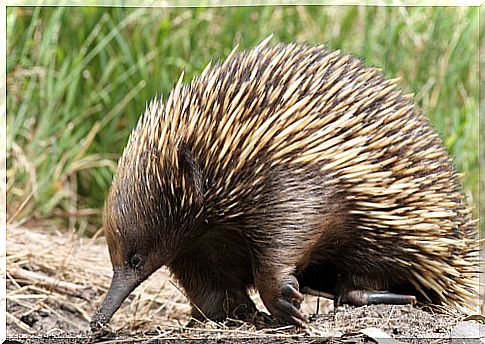Echidna Interesting Facts

The echidna or echidna is an unusual mammal that defies the categorization of its species in many ways. Some consider it a living missing link between mammals and reptiles, since the echidna and the platypus – its closest relative – are ‘monotremes’, that is, mammals that lay eggs.
However, this specimen is provided with hair and produces milk, for which it is qualified within the order of mammals. Although this fact does not prevent some scientists from suggesting separating them and creating their own classification that fits their particularity.
Some interesting echidna facts
Although it is a mammal, it lays eggs
As we mentioned earlier, the only animal that does this is the platypus, considered the most similar species to the echidna. The female echidna lays a single tiny egg, comparable to a dime.
This egg is rolled up in a bag that unfolds just before the egg is laid. After 10 days, the egg hatches and the baby, called a puggle, is born. This is nourished by the milk secreted by the mother in the bag and will be ready to come out of it at two months of age.
At that moment, the thorns begin to grow and it is suitable for it to come out of the bag. The puggle then remains in the burrow and is fed by the mother until about seven months, when it will be ready to live alone.
Long and short beaked animal that have no beak
Echidna species are classified as long-beaked or short-beaked, but this animal does not have a beak. Rather, it is a very long nose that helps them sniff the environment, the earth, and locate food. This animal feeds on termites, earthworms, and other small insects.

The echidna also uses its nose to feel the vibrations made by the prey and remains motionless waiting for it to approach. Then it uses its long, sticky tongue to catch and eat it.
Their appearance is heavy, but they are very active
The echidna can appear to be a heavy ball of thorns for its size and with little skill. But he actually has a very active lifestyle, as he can travel long distances in one day. It is also very good at defending itself and uses three options to face danger.
It is capable of running away at full speed, digging a hole, and hiding or huddling, leaving its spines exposed. Digging capacity is usually your best bet. Typically, it digs rapidly until only a spiny butt can be seen, making it impossible for a predator to grab. It also stands out for being an excellent swimmer and is very effective at climbing trees.
Thorns are actually hairs
Those long spines on the echidna are actually made of keratin. Its length can reach two inches and its ends are sharp, which helps the animal protect itself from predators.
The echidna has muscles at the base of the spine that move independently. This allows it to fit firmly into crevices in rocks or trees for protection. They also help you unwind when the strategy is to turn into a prickly ball.

Despite its strategies and morphological qualities to protect itself, the echidna is preyed upon by dingoes, wild cats, foxes, and Tasmanian devils. Another threat to this species is cars. Hundreds of echidna individuals are struck each year when trying to cross paths.
Is in danger of extinction
Three of the four known species of echidna are currently critically endangered : the Sir David’s long-beaked echidna, the eastern long-beaked, and the western long-beaked echidna. This is due to habitat destruction and indiscriminate hunting.
Although the fourth species, the short-billed echidna, is more widespread and labeled as Least Concern, it is also protected under Australian law.
Echidnas have solitary habits and their different species are distributed on Australian soil, the island of Tasmania and New Guinea. It can be seen in the snowy mountains or in the hot deserts while foraging for food. It is also known to some people as a spiny anteater.









